|
(The figures in brackets after
each name give the population in 1911.)
Aberchirder (1048), in
Marnoch parish, begun in 1746 by General Gordon of Auchintoul, was
constituted a burgh in 1889. The Rose-Innes Cottage Hospital, for the
parishes of Marnoch and Forglen was founded by Miss E. O. Rose-Innes of
Oldtown of Netherdale. In the old churchyard, two miles from the town are
the fragments of a building that had been used in succession as a Roman
Catholic, Episcopal and Presbyterian parish church. The adjacent existing
church was built about the commencement of last century. A historic event
was enacted within its walls and around them on that wintry morning of 21st
January, 1841, when the seven suspended ministers of Strathbogie met to
induct Mr John Edward to the pastorate of the parish. The proceedings of
that day rang throughout ecclesiastical Scotland and helped to precipitate
the disruption of the National Church two years later.
Aberlour (1272) is, of
right, Charlestown of Aberlour, from the name of its founder early in the
nineteenth century, Charles Grant of Wester Elchies. The parish, of the same
name, was originally Skirdustan—the division of Dustan (Drostan), its
tutelary saint. The town became a burgh in 1894. The fine Town Hall was the
gift of the late Mr James Fleming, distiller and bank agent, who left also
,C9000 to build and endow a cottage hospital for Aberlour and Loo for the
erection of a suspension foot-bridge over the Spey to connect with Knockando.
Aberlour has a large orphanage founded by the late Canon Jupp, a man of
abounding enterprise.
Banff (3821) is a very
ancient place of human habitation. Standing at the mouth of a productive
river, the town had fertile land around it. Through the friendly
co-operation of river and sea a bar formed a harbour of refuge well suited
to the wants of early navigation, and it was a member of a northern Hanse,
connection with which gave valuable trading privileges. Malcolm Canmore may
have made it a royal burgh: it is mentioned as royalty in 1057. A charter of
Robert II,
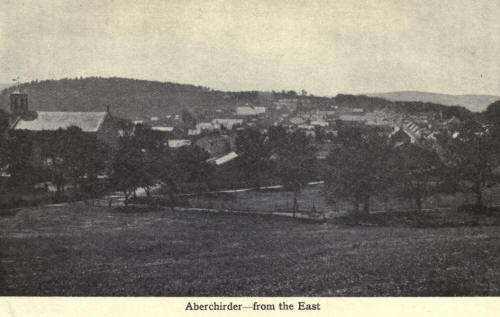
of date 1372, is still in
existence. For centuries it has been the seat of the administration of law
and local government in the county. Banff suffered from both parties in the
stormy Covenanting times: "no merchant's goods nor gear left" is the record
after a plundering by

Montrose in 1645. Soldiers
were frequently in it, sometimes quartered on it because of the non-payment
of taxes, sometimes, as after the Forty-five, to quell Jacobite ambitions in
the district.
A surgeon with Cumberland's
army in 1746 records that then the town lived chiefly by smuggling, and go
years later it is designated as "perhaps the gayest little town in
Scotland." Wolfe, the future conqueror of Canada, described Banff as "a
remote and solitary part of the globe... .When I am in Scotland, I look upon
myself as an exile." John Wesley visited Banff three times, and wrote of it
as "one of the neatest and most elegant towns that I have seen in Scotland."
Boswell
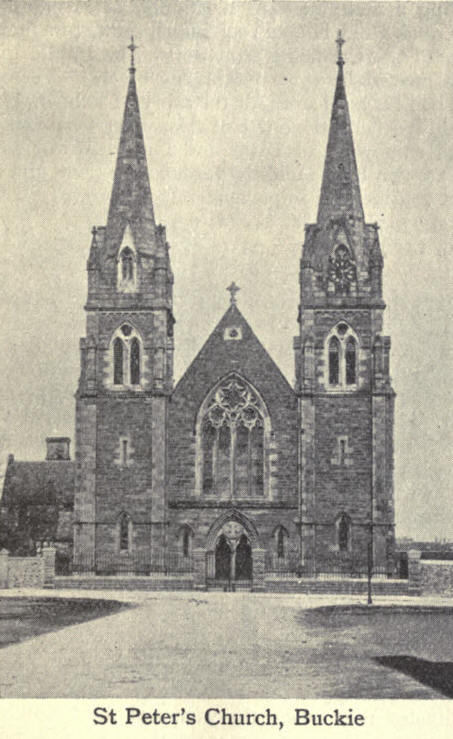
and Johnson spent a night in
it, the latter uttering a growl because the inn windows had no pulleys.
Burns stayed a night in the town, 8th September, 1787.
Byron as a boy lived for a
short time with relatives at Banff and by one indignant person was
characterised as "that little deevil, Geordie Byron." The poet Southey, who
visited Banff in 1819, with his friend Telford the engineer, then engaged in
harbour extension, wrote of it as a "clean, cheerful and active little
place."
The Town-house, built between
1796 and 1800, occupies part of the site known as the Towers, which were
almost the last remains of Lord Banff's Palace. The Burgh Cross is very old
and is mentioned in 1542. There are a number of fine memorial stones in the
old churchyard, including a monument to the family of Archbishop Sharp. Some
of the quaint old houses bear inscriptions, but little is left to mark the
site of the Carmelite monastery. The Public Library and Museum was erected
in 1902 on the site of the "Turrets," where Cumberland had his meal store
for the army. Chalmers Hospital was built and endowed from the estate of
Alexander Chalmers of Clunie, merchant and shipowner of Banff and
Gardenstown, who died in 1835. There are two boat-building yards in the town
and the fishing industry is of considerable importance.
Buckie (8897), the
earliest fishing station in Rathven parish, is the largest town in
Banffshire and has more line fishermen than any other town in Scotland. It
consists of three main divisions: Buckpool, Easter Buckie and Portessie.
Buckie, Buckpool, Ianstown and Gordonsburgh were erected a burgh in 1888 and
Portessie was incorporated in it in 19o3. The activities of the town centre
largely round the harbour, which was opened in 1879 and which, with later
additions, cost the Cluny Trustees,C8o,000 when it was purchased by the Town
Council, under whose management it has been greatly extended at a heavy
expenditure. The Buckie fishermen own a magnificent fleet of fishing craft
whose influence is felt wherever they operate round the British Isles. The
graceful twin spires of St Peter's Church, rising to a height of 115 feet,
form a notable feature of the local architecture.
Craigellachie is the
railway junction of the main line Aberdeen to Elgin and the Strathspey line
to Perth via Boat of Garten. It is beautifully situated near where the
waters of the Fiddich reach the Spey and is very popular as a summer resort.
One of the most beautiful bridges in the county is that over the Spey. The
cast-metal arch and framing, so light and airy in appearance, the embattled
towers which flank the abutments, the rugged and precipitous rocks
overhanging the river and the roadway, the dark deep pool below, the finely
wooded eminence in the background, and the picturesque accessories which
enhance the prospect on all sides, combine to render Craigellachie Bridge a
picture of no ordinary beauty and charm. It was erected in 1815 by Mr
Simpson of Shrewsbury, after a design by Telford, and withstood the floods
of 1829, when the water here rose to the height of 15 feet above the
ordinary level. The arch is 150 feet span, and the turrets rise to so feet.
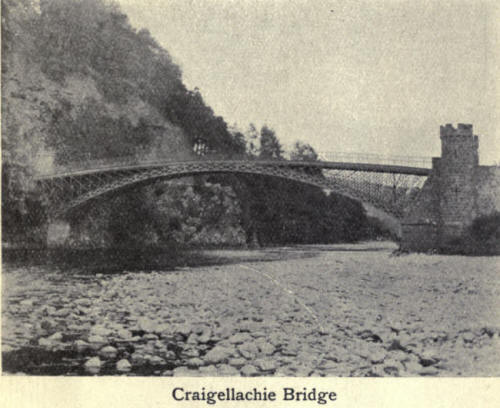
Crovie (282), a
fishing village in the very east of the county, is built close on the sea at
the base of Troup Head. It stands in a picturesque neighbourhood.
Cullen (1992) is a
town of great antiquity. It has a charter of James II, March 1455, ratifying
burghal privileges granted by Robert I. It consists of two parts, the New
Town and the Seatown. The predecessor of the former, which was called the
Old Town, was meanly built and about 1820 was utterly demolished in order to
make room for improvements at Cullen House. In March 1645 Cullen was
plundered by the Farquharsons of Braemar, by orders of Montrose, and to help
it in its distress collections were ordered to be made in all churches of
Scotland. The municipal buildings were erected in 18za at the expense of the
Earl of Seafield; the harbour provided by the Earl of Seafield in 1817 has
on various occasions since then been enlarged and improved. The Seatown is
inhabited mainly by the fishing community. In George Macdonald's novel,
Malcolm, the scene of which is laid in Cullen, it is thus described: "The
Seatown of Portlossie was as irregular a gathering of small cottages as
could be found on the surface of the globe. They faced every way, turned
their backs and gables every way-only by the roofs could you predict their
position-were divided from each other by every sort of small irregular space
and passage, and looked like a National Assembly debating a Constitution."
Cullen House grounds contain many magnificent forest and ornamental trees.
Nearly parallel to the links runs a railway embankment 5o feet in height and
connecting at its eastern extremity with a viaduct over the burn of Cullen
consisting of eight arches, each of 63 feet span and upwards of 70 feet in
height.
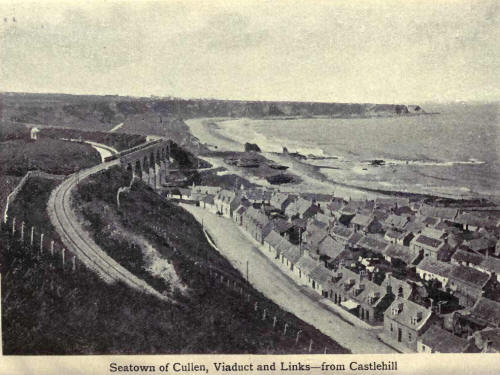
Dufftown (1626), in
the parish of Mortlach, has been a police burgh since 1863. It was founded
by the Earl of Fife in 1815. It is now one of the chief centres of the
distilling industry in Scotland and it has a flourishing business as well in
the burning of lime. A tower in the Square is a leading architectural
feature in the town. The Stephen Cottage Hospital, opened in 1890, was built
and endowed by Lord Mount Stephen, the most famous native of Dufftown. For
many years a great power in the commercial activities of Canada, he was one
of the potent forces in the construction of that work of Imperial
magnitude-the Canadian Pacific Railway. Both in this country and in the
Dominion his benefactions have been princely.
Findochty (1776),
founded in 17r6, was erected a burgh in r9r5. Fishing is the paramount
industry. In common with similar communities on the coast it has increased
much in size of late years.
Fordyce (297), a very
ancient place of settlement, was erected a burgh of barony by charter dated
1499 and renewed in 1592. Of one of its clergymen of the early
post-Reformation period, Mr Gilbert Gairdn, it is said that he "seldom went
to the pulpit without his sword, for fear of the Papists." Fordyce has for
long been best known for its secondary school, with its valuable bursaries.
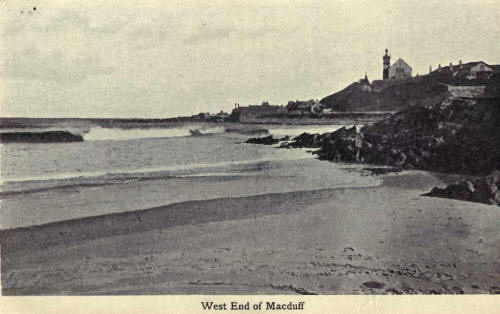
Gardenstown (1090) was
the first herring fishing station on the Moray Firth, the industry having
been established in 1812. Standing on Gamrie Bay, it is in summer a
favourite of artists, who seek to transfer to their canvases the rugged
beauties of the east "neuk" of Banffshire, with its twin villages -
Gardenstown and Crovie - its dark caves, its precipitous headlands, the home
of a great variety of seafowl, its seething cauldrons and its gigantic
chasms in the rocks through which the wind sighs and the sea waves roar.
Keith (4499) is the
chief agricultural centre of the county. It consists of three communities,
which were united into a police burgh in 1889. Old Keith, a very ancient
place, was celebrated for its annual three days' market held in September,
whither traders resorted from places as far apart as Glasgow and the
Orkneys. New Keith, on the Seafield property, was begun about 175c.
Fife-Keith, on the other side of the Isla, was founded by the Earl of Fife
in 1817. Keith is the seat of an extensive industry in meat, and has
important cloth and manure factories. The town is annually the scene of one
of the largest one-day agricultural shows in Scotland. The present Institute
buildings date from 1889, and much good work has been done in the community
by the Turner Memorial Cottage Hospital.
Macduff (3411) formed,
of old, part of the Thanage of GIendowachie, which comprised a large area
east of the Deveron. Robert the Bruce granted the Thanage and other lands to
his sister's husband Hugh, Earl of Ross. Later it was for long in the
possession of the Earls of Buchan. As a small fishing village, less than two
centuries ago, it was known as Doune or Down—it clusters along the eastern
base of the Hill of Doune—and in 1733 it was bought by William Duff of Braco,
afterwards first Earl of Fife, a family that has greatly fostered the
interests of the town. Through the exertions of the second Earl it was in
1783 erected into a burgh of barony. The harbour has been the mainspring of
the town's activities. It was purchased in 1898 by the Town Council from the
Duke of Fife and since that time a large amount of money has been spent on
its extension and improvement, and it is now one of the largest, safest and
most convenient harbours in the Moray Firth. An extensive addition—the
Princess Royal Basin. —was opened by the Princess Royal in May, 1921. The
burgh possesses a fine town hall. In the vicinity is the Howe of Tarlair
with its iron spa, situated amidst impressive rock scenery.
Newmill (558) in the
parish of Keith, the successor of a village of great antiquity, was founded
by the Earl of Fife in 1759.
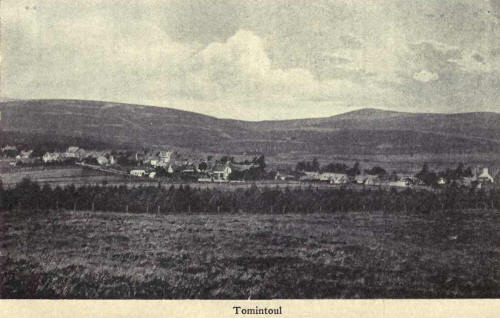
Portgordon (1369), the
most westerly town in the county, was founded in 1797 by the fourth Duke of
Gordon, after whom it is named. In 1874 it was provided by the Superior with
a new harbour, which was enlarged and deepened in 1909. In the pre-railway
era it was the port of shipment for an extensive inland area.
Portknockie (1746),
founded about 1677, was made a police burgh in 1912. Its interests are
almost entirely in fishing. It has a fine fleet of about fifty
steam-drifters.
Portsoy (1951),erected
a burgh of baronyin 155o,became a police burgh in 1889. Its industries
include fish-curing and the manufacture of oatmeal.
Sandend (356), to the
west of a beautiful bay with a fine expanse of sand, is wholly devoted to
fishing.
Tomintoul (479),
standing 1160 feet above sea-level, is the highest village in the Highlands,
while the distinction of the highest in Scotland falls to the Lanarkshire
village of Leadhills. It was founded in 1750 on what was a bleak and barren
moor, but of late years its amenities have been greatly improved; and,
possessing some of the most important attributes of a Highland health
resort, it has been described as "at once the breeziest, healthiest, and
most primitive little town in the Kingdom." Tomintoul occupies a table-land
overlooking the river Aven, with views of hills andglens and wooded passes,
with the mountains of Ben Aven and Ben Macdhui in the distance. Its railway
stations are Grantown-on-Spey (14 miles) by Wade's road via Bridge of Brown;
Ballindalloch (15½ miles) via the Faemusach or the picturesque Avenside; and
Dufftown (zo miles) by way of Glenrinnes.
Whitehills (1108), in
Boyndie, is a thriving sea-side village, almost entirely dependent on the
fishing industry. It is an important centre for line-caught white fish. A
new harbour was opened in 1900.
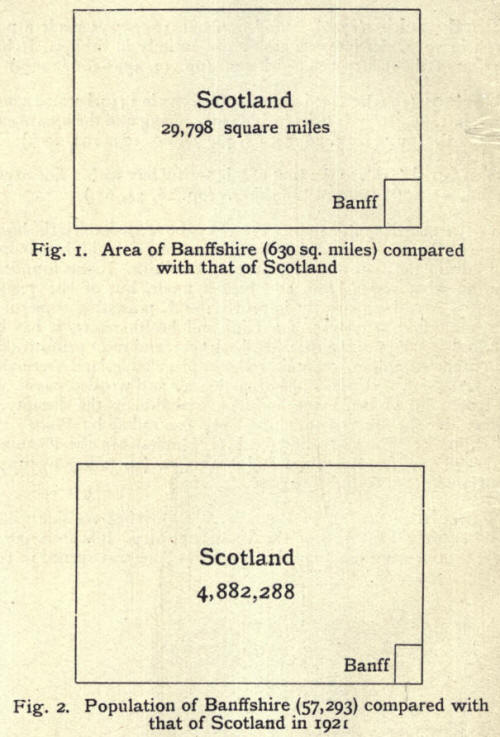
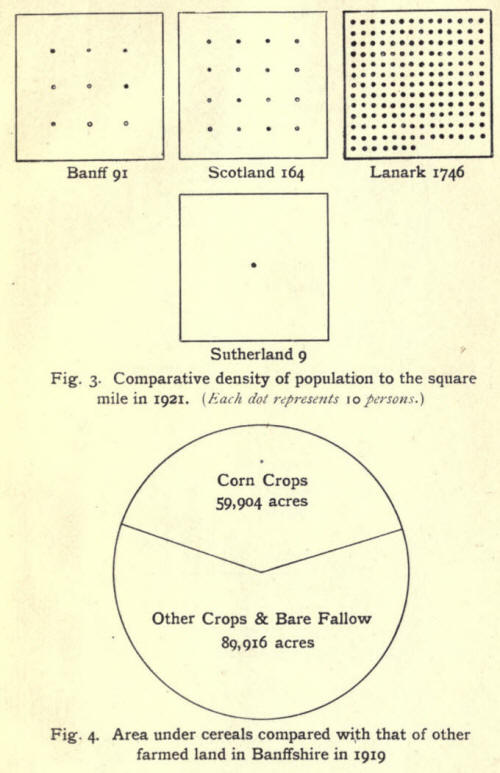
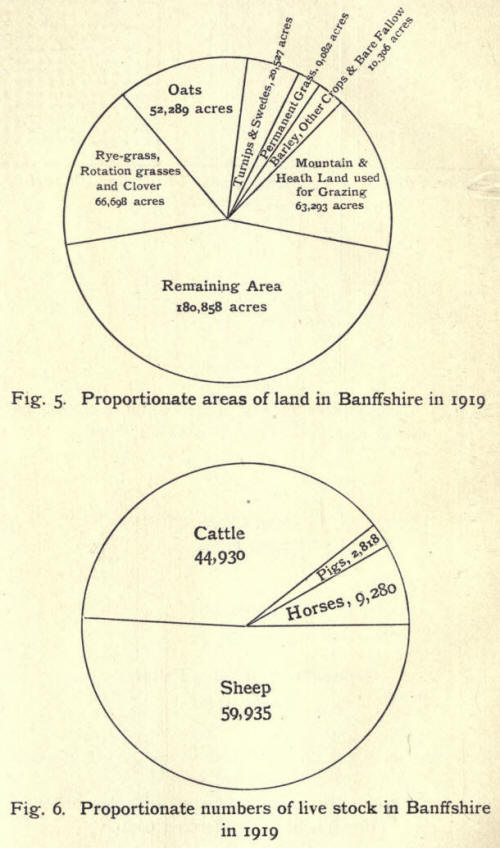

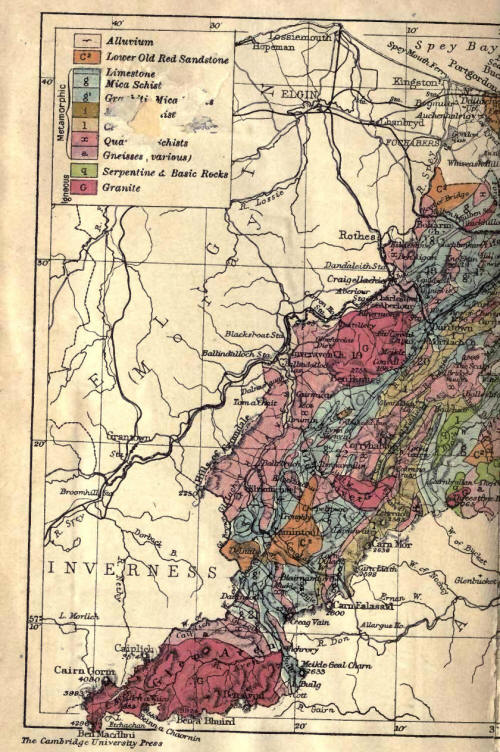
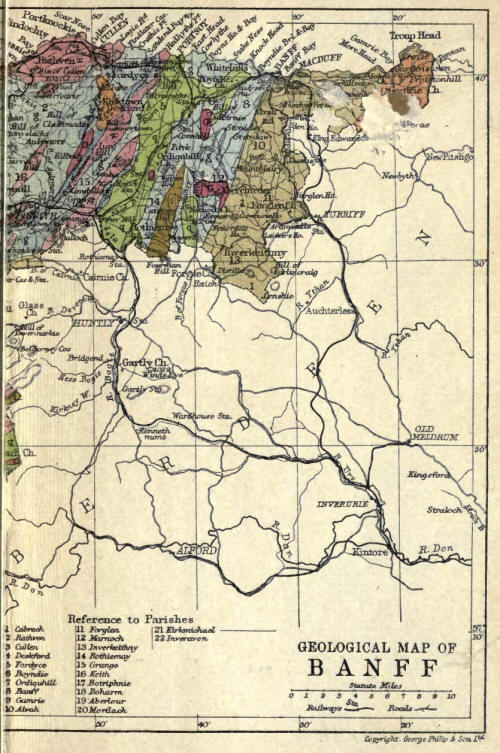 |

